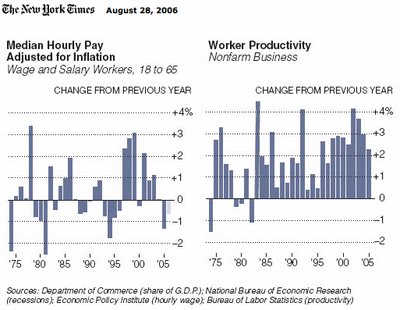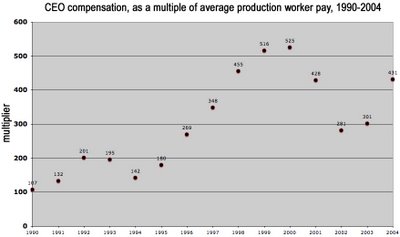The “golden era”—but not for labor
“More than 45 percent of the nation’s workers, whatever their skills, earned less than $13.25 an hour in 2004, or $27,600 a year for a full-time worker.” (The New York Times, March 26, 2006)Those who earn wages have done quite poorly when compared to CEOs, corporations, and stock earnings:

(From: “Executive Excess 2005” by Sarah Anderson and John Cavanagh, Institute for Policy Studies, and Scott Klinger and Liz Stanton, United for a Fair Economy.)Many highly trained wage-earners are faring no better than the average worker. The Federal Aviation Administration is imposing new work rules that will cut the number of Air Traffic Controllers by half at major (“Level 12”) towers, and on Labor Day will impose “compressed work schedules” that result in controllers having to begin a second shift just 8 hours after their previous shift ended, and those controllers will see their base pay cut to $31,000 per year. (Source: The Ed Schultz Show)
“One veteran United Airlines captain, who laments that when he retires in a few years his pension will be about one-fourth what he expected, said he had to shut it out of his mind to prevent the distraction from affecting his work.” (The New York Times, March 10, 2006)But some are doing very well in this “golden era” of wage depression:
“[Wages] and salaries now make up the lowest share of the nation’s gross domestic product since the government began recording the data in 1947, while corporate profits have climbed to their highest share since the 1960’s. UBS, the investment bank, recently described the current period as ‘the golden era of profitability.’ [...] In another recent report on the boom in profits, economists at Goldman Sachs wrote, ‘The most important contributor to higher profit margins over the past five years has been a decline in labor’s share of national income.’ ” (The New York Times, August 28, 2006)

The only group to see any gains are those making the highest 20 percent of income; the largest losses were seen by the 40 percent making the least amount of money:

Adapted from: “Income, Poverty, and Health Insurance Coverage: 2004,” by U.S. Department of Commerce, Economics and Statistics Administration, U.S. Census Bureau (August 2005)But the CEOs can still pull in record earnings for themselves, presumably their reward for squeezing wages and gutting pensions...

Total executive compensation: Business Week annual compensation survey, various issues, 1991-2005. Includes: salary, bonus, restricted stock, payouts on other long-term incentives, and the value of options exercised. Note: 2004 total compensation figure calculated by the authors based on data in Business Week survey. Average worker pay: BLS, Employment, Hours, and Earnings from the Current Employment Statistics Survey, Table B-2.In France, younger workers recently took to the streets to protest employers being given the new legal right to dismiss them at will: “Students and labor unions say the labor law will erode France's cherished workplace protections. Set to take effect [April 2006], it would let companies fire employees under 26 without reason in the first two years on the job.”
(Data and legend from: Figure 3 of “Executive Excess 2005” by Sarah Anderson and John Cavanagh, Institute for Policy Studies, and Scott Klinger and Liz Stanton, United for a Fair Economy.)
Meanwhile, the vast majority of American workers already live under those conditions for their entire working lives. But, employers have no compunction about demanding that employees give them the loyalty that’s in such short supply from the other direction:

If present trends continue in the cost of labor and the cost of energy, it won’t be long before we bring back the one machine that will make economic sense, at least to some:

Credit: Fernand Braudel’s The Structures of Everyday Life: Civilization and Capitalism, 15th-18th Century Volume 1 (1982)Happy Labor Day! Happy, happy, happy!!!


0 Comments:
Post a Comment
<< Home